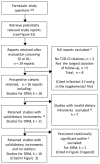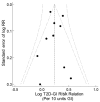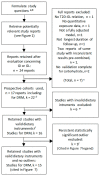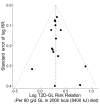Dietary Glycemic Index and Load and the Risk of Type 2 Diabetes: A Systematic Review and Updated Meta-Analyses of Prospective Cohort Studies
- PMID: 31195724
- PMCID: PMC6627334
- DOI: 10.3390/nu11061280
Dietary Glycemic Index and Load and the Risk of Type 2 Diabetes: A Systematic Review and Updated Meta-Analyses of Prospective Cohort Studies
Abstract
Published meta-analyses indicate significant but inconsistent incident type-2 diabetes(T2D)-dietary glycemic index (GI) and glycemic load (GL) risk ratios or risk relations (RR). It is nowover a decade ago that a published meta-analysis used a predefined standard to identify validstudies. Considering valid studies only, and using random effects dose-response meta-analysis(DRM) while withdrawing spurious results (p < 0.05), we ascertained whether these relationswould support nutrition guidance, specifically for an RR > 1.20 with a lower 95% confidence limit>1.10 across typical intakes (approximately 10th to 90th percentiles of population intakes). Thecombined T2D-GI RR was 1.27 (1.15-1.40) (p < 0.001, n = 10 studies) per 10 units GI, while that forthe T2D-GL RR was 1.26 (1.15-1.37) (p < 0.001, n = 15) per 80 g/d GL in a 2000 kcal (8400 kJ) diet.The corresponding global DRM using restricted cubic splines were 1.87 (1.56-2.25) (p < 0.001, n =10) and 1.89 (1.66-2.16) (p < 0.001, n = 15) from 47.6 to 76.1 units GI and 73 to 257 g/d GL in a 2000kcal diet, respectively. In conclusion, among adults initially in good health, diets higher in GI or GLwere robustly associated with incident T2D. Together with mechanistic and other data, thissupports that consideration should be given to these dietary risk factors in nutrition advice.Concerning the public health relevance at the global level, our evidence indicates that GI and GLare substantial food markers predicting the development of T2D worldwide, for persons ofEuropean ancestry and of East Asian ancestry.
Keywords: alcohol; cohort studies; dietary fiber; epidemiology; glycemic index; glycemic load; meta-analysis; protein; type 2 diabetes.
Conflict of interest statement
The following authors have no competing interests: Anette Buyken, Antonio Ceriello, Salwa Rizkalla, Richard Taylor, Antonia Trichopoulou, and Walter Willett. Arne Astrup is a consultant member of advisory boards for McCain Foods Limited, Canada, Weight Watchers, USA. He is a recipient of honoraria as a speaker for a wide range of Danish and international concerns and receives royalties from popular diet and cookery books using GI/GL. Livia Augustin has received an honorarium from the Nutrition Foundation of Italy (NFI) to co-organize a GI/GL summit. Sara Baer-Sinnott is the president of Oldways, a non-profit food and nutrition organization that receives support from a wide variety of organizations. Alan Barclay is a board member and consultant to the Glycemic Index Foundation, an international not-for-profit organization which endorses healthy low GI food products by means of a certified GI symbol. He is a co-author of lay books about the glycemic index of foods and sweeteners. Inger Bjorck is a retired professor from Lund University, Sweden, where she has managed the Antidiabetic Food Centre, a non-profitable research center including the academy, the health care system, and representatives from the industry. She is an inventor and owner of intellectual property related to the use of certain proteins, specific probiotics, and probiotics to improve glycemic regulation and metabolism. Jennie Brand-Miller is President of the Glycemic Index Foundation, an international not-for-profit organization, which endorses healthy low GI food products by means of a certified GI symbol. She manages a glycemic index testing service at the University of Sydney and is the co-author of lay books about the glycemic index of foods. Furio Brighenti is affiliated to a department of the University of Parma that does glycemic index analysis as a service to third parties. Marie-Ann Ha is a senior lecturer with Anglia Ruskin University, a Director with Cibus Biscuits Ltd., a company developing a product for people with additional energy requirements and is a Director of East Anglia Food Link, a not-for-profit organization working to increase local sourcing of local products. David Jenkins David Jenkins has received research grants from Saskatchewan Pulse Growers, the Agricultural Bioproducts Innovation Program through the Pulse Research Network, the Advanced Foods and Material Network, Loblaw Companies Ltd., Unilever Canada and Netherlands, Barilla, the Almond Board of California, Agriculture and Agri-food Canada, Pulse Canada, Kellogg’s Company, Canada, Quaker Oats, Canada, Procter & Gamble Technical Centre Ltd., Bayer Consumer Care, Springfield, NJ, Pepsi/Quaker, International Nut & Dried Fruit (INC), Soy Foods Association of North America, the Coca-Cola Company (investigator initiated, unrestricted grant), Solae, Haine Celestial, the Sanitarium Company, Orafti, the International Tree Nut Council Nutrition Research and Education Foundation, the Peanut Institute, Soy Nutrition Institute (SNI), the Canola and Flax Councils of Canada, the Calorie Control Council, the Canadian Institutes of Health Research (CIHR), the Canada Foundation for Innovation (CFI), and the Ontario Research Fund (ORF). He has received in-kind supplies for trials as research support from the Almond Board of California, Walnut Council of California, American Peanut Council, Barilla, Unilever, Unico, Primo, Loblaw Companies, Quaker (Pepsico), Pristine Gourmet, Bunge Limited, Kellogg Canada, WhiteWave Foods. He has been on the speaker’s panel, served on the scientific advisory board, and/or received travel support and/or honoraria from the Almond Board of California, Canadian Agriculture Policy Institute, Loblaw Companies Ltd., the Griffin Hospital (for the development of the NuVal scoring system), the Coca-Cola Company, EPICURE, Danone, Diet Quality Photo Navigation (DQPN), Better Therapeutics (FareWell), Verywell, True Health Initiative (THI), Institute of Food Technologists (IFT), Soy Nutrition Institute (SNI), Herbalife Nutrition Institute (HNI), Saskatchewan Pulse Growers, Sanitarium Company, Orafti, the American Peanut Council, the International Tree Nut Council Nutrition Research and Education Foundation, the Peanut Institute, Herbalife International, Pacific Health Laboratories, Nutritional Fundamentals for Health (NFH), Barilla, Metagenics, Bayer Consumer Care, Unilever Canada and Netherlands, Solae, Kellogg, Quaker Oats, Procter & Gamble, Abbott Laboratories, Dean Foods, the California Strawberry Commission, Haine Celestial, PepsiCo, the Alpro Foundation, Pioneer Hi-Bred International, DuPont Nutrition and Health, Spherix Consulting and WhiteWave Foods, the Advanced Foods and Material Network, the Canola and Flax Councils of Canada, Agri-Culture and Agri-Food Canada, the Canadian Agri-Food Policy Institute, Pulse Canada, the Soy Foods Association of North America, the Nutrition Foundation of Italy (NFI), Nutra-Source Diagnostics, the McDougall Program, the Toronto Knowledge Translation Group (St. Michael’s Hospital), the Canadian College of Naturopathic Medicine, The Hospital for Sick Children, the Canadian Nutrition Society (CNS), the American Society of Nutrition (ASN), Arizona State University, Paolo Sorbini Foundation and the Institute of Nutrition, Metabolism and Diabetes. He received an honorarium from the United States Department of Agriculture to present the 2013 W.O. Atwater Memorial Lecture. He received the 2013 Award for Excellence in Research from the International Nut and Dried Fruit Council. He received funding and travel support from the Canadian Society of Endocrinology and Metabolism to produce mini cases for the Canadian Diabetes Association (CDA). He is a member of the International Carbohydrate Quality Consortium (ICQC). His wife, ALJ, is a director and partner of Glycemic Index Laboratories, Inc., and his sister, CB, received funding through a grant from the St. Michael’s Hospital Foundation to develop a cookbook for one of his studies. Cyril Kendall has received research grants, travel funding, consultant fees, honoraria, or has served on the scientific advisory board for Abbott Laboratories, Advanced Food Materials Network, Agrifoods and Agriculture Canada (AAFC), Almond Board of California, American Peanut Council, American Pistachio Growers, Barilla, California Strawberry Commission, Calorie Control Council, Canadian Institutes of Health Research (CIHR), Canola Council of Canada, The Coca Cola Company (investigator initiated, unrestricted), Danone, General Mills, Hain Celestial, International Tree Nut Council, Kellogg, Kraft, Loblaw Brands Ltd., Nutrition Foundation of Italy, Oldways Preservation Trust, Orafti, Paramount Farms, Peanut Institute, Pepsi-Co, Pulse Canada, Saskatchewan Pulse Growers, Solae, Sun-Maid, Tate & Lyle and Unilever. Carlo La Vecchia is member of the Advisory Board of the Nutrition Foundation of Italy (NFI, honorary) and received honoraria from Soremartec and MSL Italia. Geoffrey Livesey, husband of author HFL, holds shares in Independent Nutrition Logic Ltd., a consultancy. He and his wife have benefitted from research grants, travel funding, consultant fees, and honoraria from the American Association for the Advancement of Science (USA), the All Party Parliamentary Group for Diabetes (London, UK), Almond Board of California (USA), BENEO GmbH (DE), Biotechnology and Biosciences Research Council (UK), British Nutrition Foundation(UK), Calorie Control Council (USA), Cantox (CA), Colloides Naturel International (FR), Coca Cola (UK), Danisco (UK & Singapore), Diabetes Nutrition Study Group (EASD, EU), DiabetesUK (UK), Elsevier Inc. (USA), European Commission (EU), European Polyol Association (Brussels), Eureka (UK), Food and Agricultural Organization (Rome), Granules India (Ind), General Mills (USA), Health Canada (CA), Institute of Food Research (UK), International Carbohydrate Quality Consortium (CA), Institute of Medicine (Washington, DC), International Life Sciences Institute (EU & USA), Life Sciences Research Office, FASEB (USA), Nutrition Society of Australia, Knights Fitness (UK), Leatherhead Food Research (UK), LitghterLife (UK), Matsutani (JPN), Medical Research Council (UK), MSL Group (UK), Porter Novelli (UK), Sudzuker (DE), Sugar Nutrition/WSRO (UK), Tate & Lyle (UK), The Food Group (USA), Weight Watchers (UK), Wiley-Blackwell (UK). World Health Organization (Geneva). He is a member of the EASD Nutrition Guidelines Committee. Helen Livesey, wife of Geoffrey Livesey, holds shares in Independent Nutrition Logic Ltd. (UK) and has benefitted from organizations declared by him. Simin Liu received consulting fees from Stanford University, Fred Hutchinson Cancer Research Center, honoraria from General Mills Co, and is a consultant to Barilla, Palma, Italy. Andrea Poli is the President of the Nutrition Foundation of Italy (NFI) a non-profit organization partially supported by Italian and non-Italian Food Companies. Jordi Salas-Salvadó serves on the board of, and has received grant through, his institution from the International Nut and Dried Fruit Council and the Eroski Foundation. He serves on the Executive Committee of the Instituto Danone Spain and on the Scientific Committee of the Danone International Institute. He has received research support from the Instituto de Salud Carlos III, Spain; the Ministerio de Educación years Ciencia, Spain; the Departament de Salut Pública de la Generalitat de Catalunya, Catalonia, Spain; and the European Commission. Further research support has come from the California Walnut Commission, Sacramento CA, USA; the Patrimonio Comunal Olivarero, Spain; the La Morella Nuts, Spain; and Borges S.A., Spain. He reports receiving consulting fees or travel expenses from Danone; California Walnut Commission, the Eroski Foundation, the Instituto Danone–Spain, Nuts for Life, Australian Nut Industry Council, Nestlé, Abbot Laboratories, and Font Vella Lanjarón. He is on the Clinical Practice Guidelines Expert Committee of the European Association for the study of Diabetes (EASD), and has served on the Scientific Committee of the Spanish Food and Safety Agency, and the Spanish Federation of the Scientific Societies of Food, Nutrition and Dietetics. He is an Executive Board Member of the Diabetes and Nutrition Study Group (DNSG) of the EASD. Gabriele Riccardi is a member of the scientific advisory board of Barilla Center for Food and Nutrition. John L Sievenpiper received research support from the Canadian Foundation for Innovation, Ontario Research Fund, Province of Ontario Ministry of Research and Innovation and Science, Canadian Institutes of health Research (CIHR), Diabetes Canada, PSI Foundation, Banting and Best Diabetes Centre (BBDC), American Society for Nutrition (ASN), INC International Nut and Dried Fruit Council Foundation, National Dried Fruit Trade Association, The Tate and Lyle Nutritional Research Fund at the University of Toronto, The Glycemic Control and Cardiovascular Disease in Type 2 Diabetes Fund at the University of Toronto (a fund established by the Alberta Pulse Growers), and the Nutrition Trialists Fund at the University of Toronto (a fund established by an inaugural donation from the Calorie Control Council). He has received in-kind food donations to support a randomized controlled trial from the Almond Board of California, California Walnut Commission, American Peanut Council, Barilla, Unilever, Unico/Primo, Loblaw Companies, Quaker, Kellogg Canada, and WhiteWave Foods. He has received travel support, speaker fees and/or honoraria from Diabetes Canada, Mott’s LLP, Dairy Farmers of Canada, FoodMinds LLC, International Sweeteners Association, Nestlé, Pulse Canada, Canadian Society for Endocrinology and Metabolism (CSEM), GI Foundation, Abbott, Biofortis, ASN, Northern Ontario School of Medicine, INC Nutrition Research & Education Foundation, European Food Safety Authority (EFSA), and Physicians Committee for Responsible Medicine. He has or has had ad hoc consulting arrangements with Perkins Coie LLP, Tate & Lyle, and Wirtschaftliche Vereinigung Zucker e.V. He is a member of the European Fruit Juice Association Scientific Expert Panel. He is on the Clinical Practice Guidelines Expert Committees of Diabetes Canada, European Association for the study of Diabetes (EASD), Canadian Cardiovascular Society (CCS), and Obesity Canada. He serves or has served as an unpaid scientific advisor for the Food, Nutrition, and Safety Program (FNSP) and the Technical Committee on Carbohydrates of the International Life Science Institute (ILSI) North America. He is a member of the International Carbohydrate Quality Consortium (ICQC), Executive Board Member of the Diabetes and Nutrition Study Group (DNSG) of the EASD, and Director of the Toronto 3D Knowledge Synthesis and Clinical Trials foundation. His wife is an employee of Sobeys Inc. Thomas Wolever is a part owner and receives payment as the President and Medical Director of Glycemic Index Laboratories, Inc., (GI Labs, a contract research organization) and Glycemic Index Testing, Inc., (GI Testing, which supplies services to GI Labs) Toronto, Canada. He has authored or co-authored several books on the glycemic index for which has received royalties from Phillipa Sandall Publishing Services and CABI Publishers. He has received research support, consultant fees or honoraria from or served on the scientific advisory board for Canadian Institutes of Health Research, Canadian Diabetes Association, Dairy Farmers of Canada, Agriculture Agri-Food Canada, Public Health Agency of Canada, GI Labs, GI Testing, Abbott, Proctor and Gamble, Mars Foods, McCain Foods, Bunge, Temasek Polytechnic Singapore, Northwestern University, Royal Society of London, Glycemic Index Symbol program, CreaNutrition AG, McMaster University, University of Manitoba, University of Alberta, Canadian Society for Nutritional Sciences, National Sports and Conditioning Association, Faculty of Public Health and Nutrition—Autonomous University of Nuevo Leon, Diabetes and Nutrition Study Group of the European Association for the Study of Diabetes (EASD). His wife is part owner of Glycemic Index Laboratories, Inc., and Glycemic Index Testing, Inc., and receives payment as chief financial officer of both corporations. All authors other than HFL and RT are members of the International Carbohydrate Quality Consortium.
Figures










Similar articles
-
Dietary Glycemic Index and Load and the Risk of Type 2 Diabetes: Assessment of Causal Relations.Nutrients. 2019 Jun 25;11(6):1436. doi: 10.3390/nu11061436. Nutrients. 2019. PMID: 31242690 Free PMC article.
-
Dietary glycemic index, glycemic load and cancer risk: a meta-analysis of prospective cohort studies.Eur J Nutr. 2022 Jun;61(4):2115-2127. doi: 10.1007/s00394-022-02797-z. Epub 2022 Jan 16. Eur J Nutr. 2022. PMID: 35034169
-
Coronary Heart Disease and Dietary Carbohydrate, Glycemic Index, and Glycemic Load: Dose-Response Meta-analyses of Prospective Cohort Studies.Mayo Clin Proc Innov Qual Outcomes. 2019 Feb 26;3(1):52-69. doi: 10.1016/j.mayocpiqo.2018.12.007. eCollection 2019 Mar. Mayo Clin Proc Innov Qual Outcomes. 2019. PMID: 30899909 Free PMC article.
-
Carbohydrate quality, glycemic index, glycemic load and cardiometabolic risks in the US, Europe and Asia: A dose-response meta-analysis.Nutr Metab Cardiovasc Dis. 2020 Jun 9;30(6):853-871. doi: 10.1016/j.numecd.2019.12.050. Epub 2020 Jan 13. Nutr Metab Cardiovasc Dis. 2020. PMID: 32278608
-
Dietary carbohydrate quality and quantity in relation to the incidence of type 2 diabetes: A prospective cohort study of middle-aged and older Korean adults.Nutrition. 2019 Jan;57:245-251. doi: 10.1016/j.nut.2018.04.011. Epub 2018 May 24. Nutrition. 2019. PMID: 30195245
Cited by
-
Predicting the Glycemic Index of Biscuits Using Static In Vitro Digestion Protocols.Foods. 2023 Jan 14;12(2):404. doi: 10.3390/foods12020404. Foods. 2023. PMID: 36673499 Free PMC article.
-
Healthy Aging-Nutrition Matters: Start Early and Screen Often.Adv Nutr. 2021 Jul 30;12(4):1438-1448. doi: 10.1093/advances/nmab032. Adv Nutr. 2021. PMID: 33838032 Free PMC article. Review.
-
Sex-Specific Variation in Metabolic Responses to Diet.Nutrients. 2024 Sep 1;16(17):2921. doi: 10.3390/nu16172921. Nutrients. 2024. PMID: 39275236 Free PMC article. Review.
-
Association of nutritional glycaemic indices with global DNA methylation patterns: results from the Moli-sani cohort.Clin Epigenetics. 2022 Dec 28;14(1):189. doi: 10.1186/s13148-022-01407-3. Clin Epigenetics. 2022. PMID: 36578055 Free PMC article.
-
Epigenetic Effects of Healthy Foods and Lifestyle Habits from the Southern European Atlantic Diet Pattern: A Narrative Review.Adv Nutr. 2022 Oct 2;13(5):1725-1747. doi: 10.1093/advances/nmac038. Adv Nutr. 2022. PMID: 35421213 Free PMC article. Review.
References
-
- International Diabetes Federation . IDF Diabetes Atlas. 7th ed. International Diabetes Federation; Brussels, Belgium: 2015. [(accessed on 21 March 2017)]. Available online: http://www.idf.org/diabetesatlas.
-
- Greenwood D.C., Threapleton D.E., Evans C.E., Cleghorn C.L., Nykjaer C., Woodhead C., Burley V.J. Glycemic index, glycemic load, carbohydrates, and type 2 diabetes: Systematic review and dose-response meta-analysis of prospective studies. Diabetes Care. 2013;36:4166–4171. doi: 10.2337/dc13-0325. - DOI - PMC - PubMed

